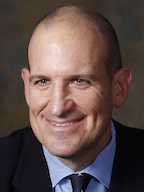Breast Augmentation
Breast augmentation or breast enlargement is a surgical procedure to increase the size of woman's breasts by placing breast implants under breast tissue or chest muscles. Some women feel that large breasts are more attractive than small or average size breasts. Their breasts did not develop to the desired size or they may have lost volume due to pregnancy, weight loss, or aging. For these women, breast augmentation may provide a more flattering, better proportioned figure, expanded clothing options, and feelings of greater confidence and self-esteem.
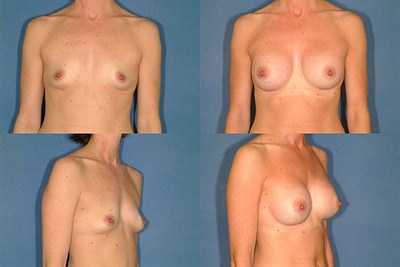 |
| Breast Augmentation Before and After - Source: Public Domain Image |
Factors to Consider Before Undergoing Breast Augmentation
Breast augmentation is a surgical procedure with all the attendant operative and anesthetic risks. The procedure involves the use of an implantable medical device. Devices can fail and there are long-term considerations that arise with the presence of a foreign material in the body. Discussion of these points is a key element of the consultation with the plastic surgeon before surgery. Several major factors to consider include:
- Statistics show that breast augmentation is not a one time intervention. Women with implants can expect to need additional surgery over the years for problems such as shifting of the implant, leakage, and hardening scar around the implant.
- If an individual later decides to remove breast implants, the breasts do not revert to their appearance before surgery. The tissue is stretched when an implant is placed under it and may appear flat and droopy when the implant is removed.
- Persons with health conditions that impair wound healing or immunologic diseases that diminish the ability to combat infection should be cautious about obtaining an implanted material.
- Individuals who are emotionally vulnerable and find it difficult to handle set-backs should consider that breast augmentation carries the burden of dealing with an implant that is not a lifetime device. The potential for complications over the long term is a psychological burden some may not wish to assume.
- Breast augmentation is cosmetic surgery and its costs are not covered by health insurance. Significantly, later costs associated with breast implants such as medical care, additional operations, and special studies to check for implant integrity may not be covered by health insurance.
- Statistics from the American Society of Plastic Surgeons show the average physician fee in 2007 for breast augmentation was $3,816. The cost of implants is in addition to the surgical charges, and gel implants are more expensive than saline implants.
Impact on Future Mammography
The presence of implants affects the way mammograms are done, since additional views are needed during routine screening mammography to visualize all of the breast tissue. Implants also may lessen the effectiveness of mammograms by making them more difficult to interpret in some cases. Women with a strong family history of breast cancer or a personal history of breast abnormalities must consider whether implants could be an impediment to cancer surveillance.
Discussion with a Knowledgeable Plastic Surgeon
For someone considering breast enlargement, there are more issues to be considered than with most surgical procedures. It is critically important for a patient to have a comprehensive consultation with a knowledgeable plastic surgeon to become familiar with the short and long term implications of the surgery. This includes an open and realistic discussion of the procedure and its potential benefits and risks. It and a plan for postoperative check-ups in the years to follow.
Patients should understand the many techniques and implant options and how these apply to them. Such factors include:
- Which type of implant is best for a given body build?
Is there breast drooping? - Is there a family history of breast cancer?
- Is the likelihood of additional surgery over the years acceptable?
- Are the costs of the required long-term follow-up as well as the original surgery clear?
Surgical Planning
For every individual there are a variety of features that have an impact on the surgical goal - a fuller breast with a natural appearance and pleasing shape. The wishes of the patient are most important but these have to be put in the context of her anatomy, including height, weight, shape of the rib cage, position of the breasts, differences between the two breasts, presence of any ptosis, and tightness of the skin.
Dimensions of the breast like width, height, and the amount the breasts protrude into the cleavage and sideways from the body should match the individual's body build. The tightness of the skin is critical. A patient with very tight skin cannot accommodate as much increase in volume as can someone with more skin.
Mastopexy
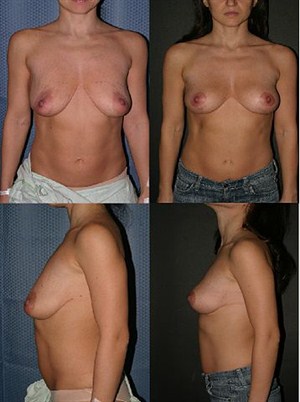 |
| Mastopexy Before & After Source: Image by Otto J. Placik - Licensed under the Creative Commons Attribution-Share Alike 3.0 Unported license. |
A patient with exceptionally thin, inelastic skin will develop ptosis or drooping when large amounts of weight and volume are introduced into the breast.
In situations where a patient already has ptosis before augmentation of the breast, this will need to be corrected before the breast volume is increased in order to avoid worsening the degree of drooping.
Surgery done to correct ptosis is called mastopexy, Mastopexy or breast lift surgery may involve repositioning the areola and nipple, as well as lifting the breast tissue and removing skin.
Mastopexy may be performed as a separate procedure, or in combination with placement of breast implants. However, when the procedures are combined, the length of the surgery is longer surgery and there will likely be more scarring.
Surgical Techniques
The basic steps of breast augmentation start with an incision made in the skin and underlying tissue. A pocket is created for a breast implant and the implant is placed and positioned. The pocket and incisions are closed surgically and dressings are used. Within this general description are a large number of technical variations.
Implants
All modern breast implants, regardless of filling material, have an outer shell or envelope constructed of silicone elastomer. Silicone is rubber and is used in numerous medical devices including heart valves, drains, catheters, and other implants such as chin, hand, and testicular implants. The implants come in many sizes and a variety of shapes such as round, oval, or contoured for more directed projection in one area of the breast. The contoured implants sometimes are called anatomic implants, a term which refers to their design with tapering on the top half and more fullness on the bottom half which mimics the natural shape of the more mature breast.
Silicone Gel-filled Implants
| Source: Food and Drug Administration website - www.fda.gov |
These implants contain silicone gel which is polymerized to a consistency very similar to that of breast tissue and as a result they weigh, feel, and move like breast tissue. Gel implants that are currently available have a thicker, more viscous gel than did previous generations of these devices. Called cohesive gel, the material tends to stay in place even if the shell of the implant is damaged. Gel implants are prefilled and sealed and cannot be adjusted in size in the operating room.
Saline-filled Implants
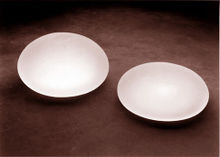 |
| Source: Food and Drug Administration website - www.fda.gov |
These silicone rubber shells are filled in the operating room by the surgeon with sterile saltwater, called saline. Should the implant leak, the saline which is used routinely as IV or intravenous fluid is absorbed harmlessly by the body. Advantages of saline implants are the safety factor of the filling material, some flexibility adjusting size by varying the amount of fluid put in the implant, and smaller incisions since the implants are inserted while empty. The primary disadvantage is a higher incidence of visible rippling or wrinkling of the implant under the skin, particularly in thin patients.
Textured Implants
The surface of implants can be smooth or textured. The texturing of the silicone elastomer on the surface of the shell was once thought to decrease the chances of hardened scarring around the implants. It may, in fact, contribute to lower rates of implant rupture since the textured shell is thicker. The texturing also tends to stabilize the implant is one position in the pocket, a desirable effect in some situations.
Location of the Implant Pocket
The pocket into which the breast implant will be placed can be in one of two positions relative to the breast tissue and the pectoralis major muscle fascia which lies deep to the breast. Subglandular placement is where the pocket is made directly behind the breast tissue on top of the muscular fascia. This lends more ability to control the shape of the breast and is associated with a more rapid postoperative recovery. Disadvantages include a greater chance of seeing or feeling the edge of the implant through the skin.
- Subglandular placement is where the pocket is made directly behind the breast tissue on top of the muscular fascia. This lends more ability to control the shape of the breast and is associated with a more rapid postoperative recovery. Disadvantages include a greater chance of seeing or feeling the edge of the implant through the skin.
- Submuscular placement is where the pocket is made underneath the chest wall muscle. The contour of the breast may be smoother because the edges of the implant are blunted by the muscle, there is less chance of developing hardened scar around the implant, nipple sensation is protected, and mammogram interpretation may be more accurate when the breast tissue is lifted up and away from the implant by the muscle. Disadvantages include more postoperative discomfort and longer recovery, movement of the implant when the muscle is flexed, and less ability to fill the upper breast centrally because the muscle tends to smooth the shape in this area.
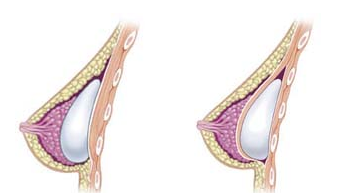 |
Diagrams of cross sections of breast implants, subglandular (left) and submuscular (right) - Source: Food and Drug Administration website - www.fda.gov |
Postoperative Care
After surgery, it is useful to wear selected garments to stabilize the position of the implant. A small dressing is placed over the incision and a bra worn for support and comfort can be adjusted to help mold the shape of the breast. An elastic wrap may be used on the upper part of the breast to keep the implant low in the pocket or to maintain the orientation of a contoured anatomic implant until healing is completed.



